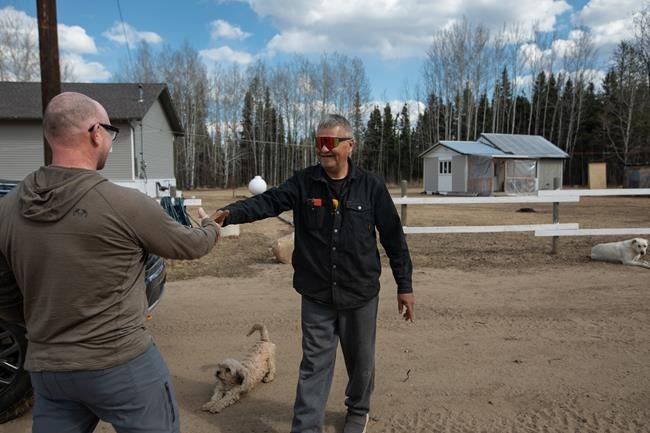CHARD, Alta. — Raoul Montgrand, president of the Chard Métis Nation in northern Alberta, called a 200-square-foot camper trailer home for close to two years.
The community leader and his wife were among the many residents affected by an ongoing housing crisis in the isolated hamlet, located about an hour-and-a-half drive southeast of Fort McMurray.
But Montgrand, who now lives in a beautiful new pre-fabricated home situated just a stone's throw from his old trailer, says what bothered him most about the dire housing conditions in Chard was what it meant for the community's children.
"Before, we would see five or six families in one house," Montgrand said in a recent interview.
"Without a house, there's no education. How are the kids going to go to school without a house to live in?"
The Chard Métis Nation is one of six Indigenous communities in northern Alberta that are part of Cenovus Energy Inc.'s Indigenous Housing Initiative. Announced by the company in January 2020, the program pledged $50 million to build homes in the First Nations and Métis communities closest to its oilsands operations in northern Alberta.
Four years later, more than 120 homes have been funded by the program, with the goal of getting to 200. In Chard alone, close to half of the 650 residents in the community will have received new homes by the end of the program's five-year lifespan.
Alex Pourbaix, former CEO and current executive chair of Cenovus, said the housing initiative represents the largest community investment in the company's history. He said it was his own visit to northern Alberta Indigenous communities — many of whom provide services and contract workers to the oilsands sector — that inspired the program.
"I was frankly shocked at the state of the housing situation in many, if not all, of these communities," Pourbaix said in an interview.
"They didn't have the resources to maintain their existing houses. And as a result, they had so many people in the line for housing with no real reasonable expectation of getting good housing. And this was everything from, you know, elderly widows and widowers to young mothers with young children."
The situation on the Chard Métis Nation — where prior to the partnership with Cenovus, many residents lived in dwellings with damaged roofs, broken windows, even black mold infestations — is a microcosm of Canada's broader Indigenous housing crisis.
According to Statistics Canada, in 2021, more than one in six Indigenous people in this country lived in crowded housing that was considered not suitable for the number of people who lived there. Indigenous people were almost twice as likely to live in crowded housing, compared with the non-Indigenous population.
More than 16 per cent of Indigenous Canadians in 2021 lived in housing that was in need of major repairs, Statistics Canada data shows.
On reserve, First Nations themselves are responsible for providing and managing housing for their people. First Nations communities receive annual funding from the federal government that can be used for everything from construction and maintenance to insurance and mold remediation.
But advocates say existing funding models aren't enough. In a recent report, the Assembly of First Nations said Indigenous communities across Canada are in urgent need of 157,453 new homes to address their ongoing housing crisis. The AFN said the federal government will have to invest more than $135 billion to close the Indigenous housing gap by 2030.
Under the Cenovus Housing Initiative, the individual communities themselves decide how to procure the homes and administer the program, which is why the funding has resulted in a mix of homes of different styles and sizes, including pre-fabricated homes and homes built onsite.
As part of the program, Cenovus launched a 24-week construction and trades readiness program in partnership with a local college to teach home construction and maintenance skills to members of the participating communities.
"The No. 1 thing I would say is that if we want to really take a shot at solving the Indigenous housing crisis, we need to actually look to the Indigenous people and their leadership," Pourbaix said.
"They are closest to the problem. They understand the problem, and I think the more decision-making ability we can put in their hands, the better outcome that we're going to have."
Still, the program has served to demonstrate why building houses in remote Indigenous communities is so challenging. Everything from construction materials to appliances and furniture is in short supply in these communities, and trucking them in from far away is expensive.
Additionally, in many cases, new homes are designated for lots that had never before been serviced. Connecting water and power to them is — in the words of Justin Herman, CEO of Chard Métis Nation — "expensive as heck."
"It's not so simple as, here's a bill to connect the utilities from this pole to that pole," Herman said.
"No, we had to put the pole up in the first place, and a super transformer so the power could get to that location. It all ends up being an additional cost."
Herman said his community has received eight homes already through the program, and expects to receive six more by the end of year. He added seeing the look on community members' faces on the day they move in to their new home is, for him, its own reward.
“They’re exuberant — a lot of pride. Other than a sense of elation, it’s a sense of relief. Because they probably felt they’d never be a homeowner," he said.
This report by The Canadian Press was first published May 1, 2024.
Companies in this story: (TSX:CVE)
Amanda Stephenson, The Canadian Press




